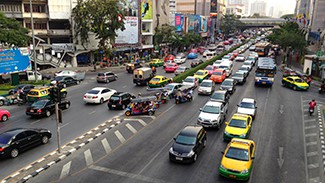Traffic Accidents in a City

(credit: modification of work by David McKelvey, Flickr)
In the chapter opener, we stated the following problem: Suppose that at a busy intersection, traffic accidents occur at an average rate of one every three months. After residents complained, changes were made to the traffic lights at the intersection. It has now been eight months since the changes were made and there have been no accidents. Were the changes effective or is the 8-month interval without an accident a result of chance?
Probability theory tells us that if the average time between events is [latex]k[/latex], the probability that [latex]X[/latex], the time between events, is between [latex]a[/latex] and [latex]b[/latex] is given by
Thus, if accidents are occurring at a rate of one every 3 months, then the probability that [latex]X[/latex], the time between accidents, is between [latex]a[/latex] and [latex]b[/latex] is given by
To answer the question, we must compute [latex]P\left(X\ge 8\right)={\displaystyle\int }_{8}^{+\infty }3{e}^{-3x}dx[/latex] and decide whether it is likely that 8 months could have passed without an accident if there had been no improvement in the traffic situation.
Candela Citations
- Calculus Volume 2. Authored by: Gilbert Strang, Edwin (Jed) Herman. Provided by: OpenStax. Located at: https://openstax.org/books/calculus-volume-2/pages/1-introduction. License: CC BY-NC-SA: Attribution-NonCommercial-ShareAlike. License Terms: Access for free at https://openstax.org/books/calculus-volume-2/pages/1-introduction
